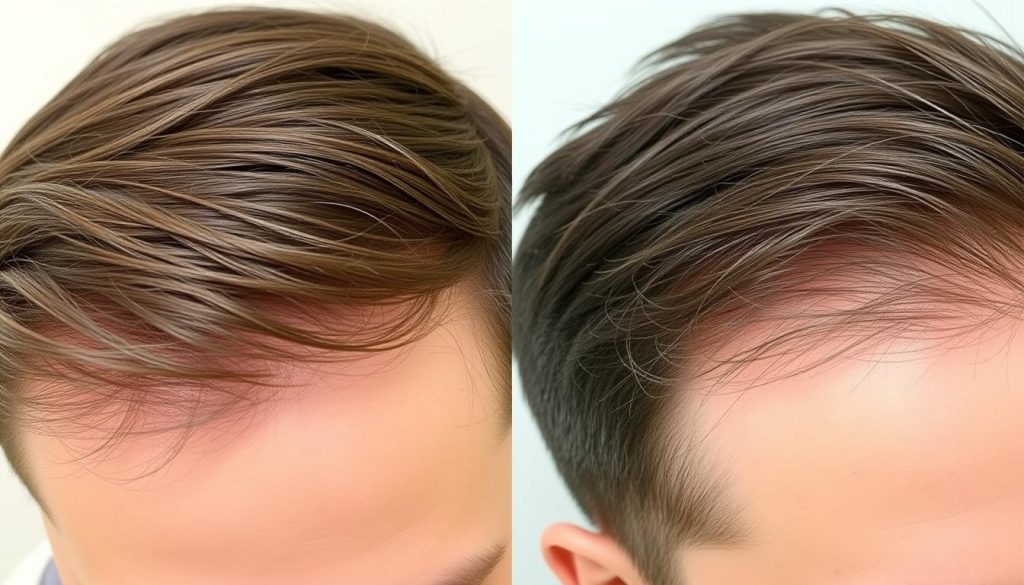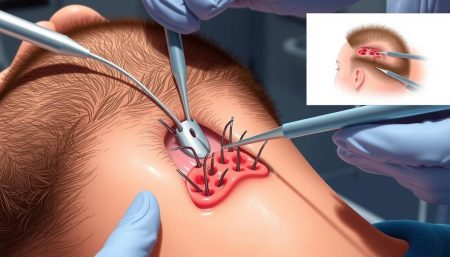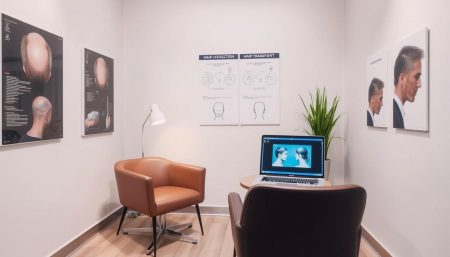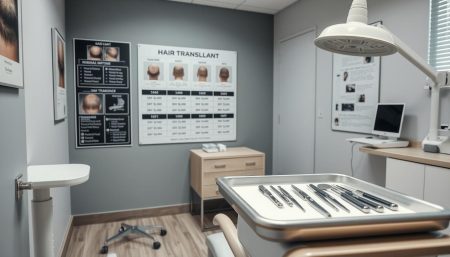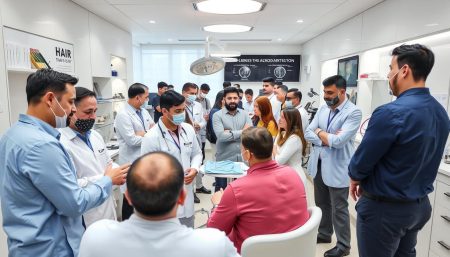Looking to boost your confidence with more hair? The best hair transplant options in the US combine cutting-edge tech with skilled surgeons. Top clinics focus on natural-looking results, tailoring each procedure to fit your needs.
These clinics pay close attention to both looks and patient care. From the first meeting to the final result, it’s a journey of change. It’s a chance to see the beauty of natural hair growth.
Understanding Hair Transplant Surgery in the USA
In the USA, the fight against hair loss has led to big steps forward. Advanced hair restoration techniques have improved a lot. Hair transplant surgery is now more effective and gives better results.
This surgery moves hair follicles from thick areas to thin ones. It uses Follicular Unit Extraction (FUE) and Follicular Unit Transplantation (FUT). Both methods aim for natural-looking hair.
The cost of hair transplant surgery changes based on several things. These include how much hair needs to be moved, the surgeon’s skill, and where the clinic is. Prices vary a lot, showing the complexity and technology used.
Evolution of Hair Transplant Methods:
- FUE: This method takes hair follicles one by one from the scalp without removing a strip of skin.
- FUT: It takes a small strip of skin from the scalp, then cuts it into individual follicles.
New methods are less invasive and make recovery faster. They also make the process more comfortable for patients.
| Method | Brief Description | Recovery Time | Cost Estimate |
|---|---|---|---|
| FUE | Less invasive, no stitches required | 7 days | $4,000 – $15,000 |
| FUT | More extensive coverage, involves stitches | 10 days | $5,000 – $12,000 |
With today’s advanced hair restoration techniques, it’s key to talk to certified experts. They can give a detailed plan for your hair loss.
Understanding the cost of hair transplant surgery is also important. It helps make a well-informed choice.
Top Hair Restoration Techniques Currently Used
The need for good hair restoration solutions is growing fast. New advanced hair restoration techniques are being developed. Follicular Unit Extraction (FUE), Follicular Unit Transplantation (FUT), and Direct Hair Implantation (DHI) are leading methods today. Each has its own benefits and has been improved to better meet patient needs.
Follicular Unit Extraction (FUE)
FUE is a top choice for hair transplants. It’s known for being less invasive and giving great results. This method takes follicles from the back of the scalp one by one with a special tool.
FUE heals quickly and leaves little to no scars. This makes it perfect for those who like to keep their hair short. Even though it costs more, its precision and flexibility make it popular.
Follicular Unit Transplantation (FUT)
FUT, or the strip method, removes a strip of scalp. Then, individual follicles are taken out and moved to thinning spots. It’s good for those with a lot of hair loss because it can do many grafts at once.
But, it takes longer to heal and leaves a line scar. This scar can be hidden by longer hair.
Direct Hair Implantation (DHI)
DHI is known for its precise hair follicle placement. It uses a special tool called the DHI implanter or Choi pen. This advanced hair restoration technique gives a fuller, more natural look by controlling where each follicle goes.
DHI has less bleeding and heals faster than other methods. But, it’s more detailed and can be more expensive.
Choosing between FUE, FUT, and DHI depends on your hair loss, scalp, and what you want. If you’re thinking about a hair transplant, talk to a skilled surgeon. They can help pick the best option for you. More info on finding the right clinic and surgeon is here.
The Cost of Hair Transplant Surgery Across the USA
Looking into the hair transplant surgery cost is key for those thinking about it. In the United States, prices for hair transplants differ a lot. This is due to several things like where the clinic is, the surgeon’s skill, and the technique used. Knowing these can help find a good deal and plan your budget better.
Hair transplant surgery costs can range from a few thousand to over twenty thousand dollars. This depends on how many grafts you need and how complex the surgery is. Places like New York and Los Angeles, with their high costs of living, usually charge more. But, clinics in smaller towns or less crowded states might be cheaper.
To get a better idea of what hair transplant surgeries cost in the USA, here’s a simple table. It shows average prices based on different techniques and locations:
| Region | Technique | Average Cost |
|---|---|---|
| East Coast (e.g., New York) | FUE | $15,000 |
| West Coast (e.g., California) | FUT | $12,000 |
| Midwest (e.g., Chicago) | DHI | $10,000 |
| South (e.g., Texas) | FUE | $7,000 |
Getting an affordable hair transplant doesn’t mean you have to settle for less quality. Many clinics offer payment plans or special deals. Some people even travel to places with lower hair transplant surgery cost to save money, even after adding travel costs.
Choosing where and how to get a hair transplant should be well thought out. Research and talking to experts are key. This way, you can find a balance between cost and quality, leading to successful hair restoration.
Factors Contributing to a Successful Hair Transplant
A successful hair transplant comes from picking a great surgeon and following good care after surgery. This part talks about how these key points work together to improve hair restoration success.
Choosing the Right Surgeon
Finding the right hair transplant surgeon is key for success. The surgeon’s skills, experience, and knowledge greatly impact the results. Look for certifications and training in hair restoration.
Also, check out what past patients say. Their stories can tell you a lot about the surgeon’s success and how happy patients are.
Post-Surgery Care and Maintenance
Good care before and after surgery is essential for great results. Proper care helps prevent infections and keeps the grafts in place. Your surgeon will give you all the details you need to follow.

To keep the results looking good, follow your surgeon’s advice closely. It’s also a good idea to go back for check-ups. This mix of skilled surgery and careful aftercare is the best way to keep your hair transplant looking great.
Identifying the Best Hair Transplant Specialists in the USA
Finding an expert hair transplant surgeon requires careful research. You need to look at their qualifications, experience, and the clinic’s reputation. This helps you understand their skills and success rates.
Accreditation and certification are key when choosing a specialist. A certified surgeon follows strict medical standards. Also, patient feedback is very important. It shows how well the surgeon and clinic work with patients.
Looking at before and after photos is also important. These photos show the surgeon’s skill and the clinic’s success. For more information on finding a top hair transplant surgeon, check out detailed guides and reviews.
- Qualifications: Ensure the surgeon has relevant, accredited medical training.
- Experience: Opt for surgeons who have a long-standing practice in hair transplantation.
- Accreditations: Check for affiliations with prominent medical associations.
- Patient Testimonials: Read through as many reviews as possible.
- Before and After Gallery: Carefully assess the quality of outcomes.
Choosing the right expert hair transplant surgeon and clinic is key. It leads to better results and a more satisfying experience. Taking your time in this process ensures your safety and quality care.
The Importance of Natural Hair Transplant Results
Looking for natural hair transplant results is key when you think about getting a hair transplant. It’s not just about the skill of the surgeons. It also depends on understanding hairline design and the qualities of the donor hair.
Artistic Hairline Design
Creating a natural-looking hairline is both art and science. It’s not just about putting hair grafts in the right place. It’s about considering facial symmetry, age, and hair type. A good hairline balances your features and hides the surgery signs.
Donor Hair Characteristics
The quality, density, and texture of donor hair matter a lot. Choosing the right donor area and matching the grafts with the recipient site is key. This ensures the transplant looks natural, boosting your confidence.
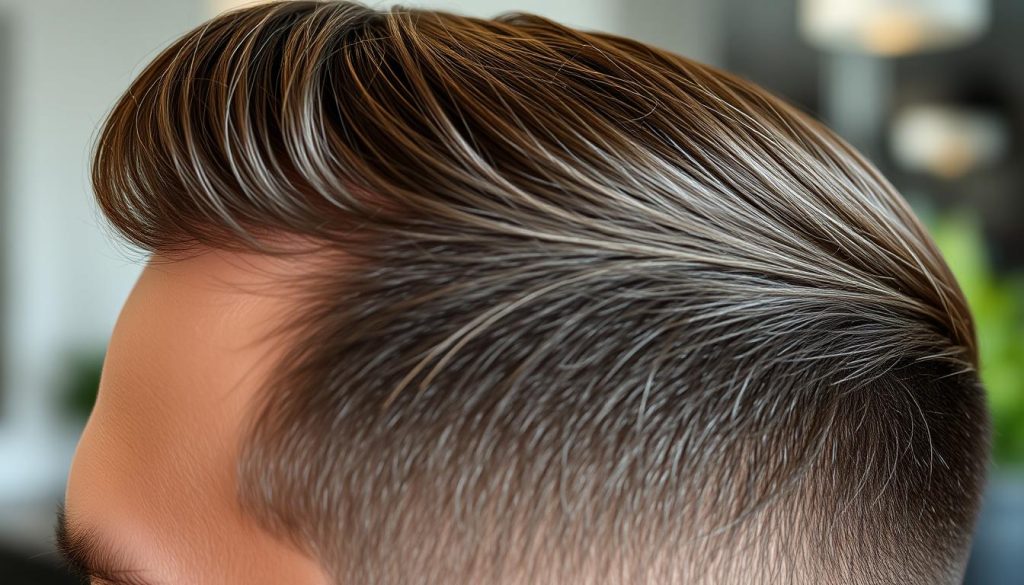
Knowing these details shows why natural results are more than just grafts. It’s about the design and choosing the right hair. This approach not only improves how you look but also affects your emotional and mental health.
Comparing Before and After Photos of Hair Transplant Procedures
Looking at hair transplant before and after photos is key for those thinking about this big step. These pictures show how well hair restoration works. They also give a clear idea of what a successful hair transplant can do.
When checking these photos, look at the hairline, how dense the hair is, and how much better the person looks. These pictures are very helpful. They help set clear expectations and help pick the best treatment.
- Consistency: Make sure the lighting, angle, and hairstyle are the same in both photos for a fair comparison.
- Healing: See how well the transplanted hair heals and blends in. This shows the success of the procedure.
- Coverage: Check how much of the bald area is covered. This shows how well the donor hair was used.
| Aspect | Before | After |
|---|---|---|
| Hairline Position | Receding | Natural and Lowered |
| Density | Sparse | Thick and Even |
| Overall Appearance | Older, Less Confident | Youthful, Enhanced Confidence |
By studying hair transplant before and after photos, people can see the big change it makes. This helps them decide if they want to get a hair transplant. It also helps them choose a clinic that has a good track record of successful hair transplant results.
Best Hair Transplant Options for Different Hair Types
Choosing the right hair transplant is key for natural-looking results. Each hair type, like fine, thick, or curly, needs special care. This ensures the transplant looks good and lasts long.
Options for Fine Hair
Fine hair is tricky because it’s delicate and can easily get damaged. Experts suggest using smaller grafts and placing them carefully. This helps create a full look without harming the grafts.
Options for Thick Hair
People with thick hair are lucky because it makes the transplant look fuller. FUE and DHI are great for this. They let you pack grafts tightly for a bigger impact.
Options for Curly Hair
Curly hair needs a careful touch to match the natural curl. This ensures the grafts grow like your own hair. It keeps the curls looking natural and intact.
| Hair Type | Recommended Technique | Key Considerations |
|---|---|---|
| Fine Hair | Follicular Unit Transplantation (FUT) | Utilizes microscopic dissection to preserve delicate follicles. |
| Thick Hair | Follicular Unit Extraction (FUE) | Allows for precise, dense packing, enriching the voluminous look. |
| Curly Hair | Direct Hair Implantation (DHI) | Ensures accurate angle and depth matching the natural curl pattern. |
Locations of Top-Rated Hair Transplant Clinics in the USA
The search for the best hair transplant locations leads to top spots in the United States. These places are known for their expert clinics and new hair restoration techniques. They offer great service, cutting-edge tech, and skilled surgeons.
Some places stand out because of their skilled professionals, easy access, and investment in medical tech. Beverly Hills, New York City, and Miami are favorites for top hair transplantation services. These cities have elite doctors and strong support for medical education and tech.
New places are also becoming known for their quality services at good prices. This opens up options for more people looking for affordable, reliable hair care.
| Location | Known For | Accessibility |
|---|---|---|
| Beverly Hills, CA | High-end, celebrity surgeons | Excellent |
| New York City, NY | Innovative hair restoration technologies | Excellent |
| Miami, FL | Luxurious settings, top-notch professionalism | Great |
| Houston, TX | Cost-effective, reliable results | Good |
| Chicago, IL | Seasoned experts, diverse techniques | Good |
In conclusion, finding the best hair transplant locations means looking at clinic reputation and the area’s environment. With the right research, you can find the perfect place for your hair care needs.
How to Assess Advanced Hair Restoration Techniques
The world of hair restoration is changing fast. It’s hard to tell what’s real and what’s just marketing. This section looks at how new tech has changed hair transplantation and growth. We focus on robotics, AI, and other new ways to help hair grow back.
The Role of Robotics and AI in Hair Transplantation
Robotics and AI have brought a new level of precision to hair transplantation. They help surgeons place hair grafts more accurately. This means better-looking results and less time recovering for patients.
Systems like the ARTAS Robotic Hair Transplant are less invasive than old methods. They cut down on mistakes and make sure results are consistent.
Emerging Technologies in Hair Regrowth
New tech is also making big strides in hair growth. Low-level laser therapy (LLLT) and Platelet-Rich Plasma (PRP) injections are getting a lot of attention. They help wake up dormant hair follicles and make hair thicker without surgery.
Looking at these new hair restoration methods, we see many options. Each one meets different needs and preferences. Here’s a closer look:
| Technique | Description | Benefits | Ideal Candidate |
|---|---|---|---|
| Robotics & AI | Automated hair transplant systems | High precision, lower risk of human error, quicker recovery | Individuals looking for minimally invasive options |
| Low-Level Laser Therapy (LLLT) | Application of wavelengths of light to promote hair growth | Non-invasive, painless, stimulates cellular activity | Patients with thinning hair |
| Platelet-Rich Plasma (PRP) | Injections of a concentration of a patient’s own platelets | Encourages hair growth by activating follicles | Individuals with active hair follicles |
Now, people have better and more reliable ways to restore their hair. As new tech keeps improving, we can expect even better, less invasive options. This is changing what we expect from hair restoration.
Planning Your Hair Transplant: A Step-by-Step Guide
Starting a hair transplant journey can change your life. To get a successful hair transplant, you need to plan carefully. We’ll guide you through the steps to plan hair restoration well.
- Initial Research: Start by looking for top hair transplant clinics. Read what past patients say and check their before-and-after photos.
- Consultation with Specialists: Meet with several experts to get different views and plans. This helps you see who offers the best care and skill.
- Evaluating Financial Options: Think about the costs, including travel if the clinic is far. Look for clear pricing.
- Medical Evaluation: Get a detailed check-up to see if you’re a good candidate. Talk about your health, hair loss, and medical history.
- Choosing the Right Procedure: Pick a method like FUE, FUT, or DHI based on your specialist’s advice.
- Pre-Operative Preparations: Follow your surgeon’s advice on what to do before surgery. This might include special diets or avoiding certain meds.
- The Procedure: On surgery day, make sure you have someone to support you and a way to get home. Recovery starts right after surgery.
- Post-Operative Care: Stick to your surgeon’s post-surgery care plan. This helps your grafts heal and succeed.
- Follow-up Appointments: Go to all follow-up visits. They help track your transplant’s progress and scalp healing.
By carefully planning your hair restoration, you’re well-prepared for a successful hair transplant. Success also depends on how well you care for yourself after the procedure.
Affordable Hair Transplant Options for Budget-Conscious Patients
For those looking for cost-effective hair restoration, knowing about affordable hair transplant options is key. Modern medical tech makes it possible to get natural-looking results without breaking the bank. This part looks at ways to save money without losing quality.
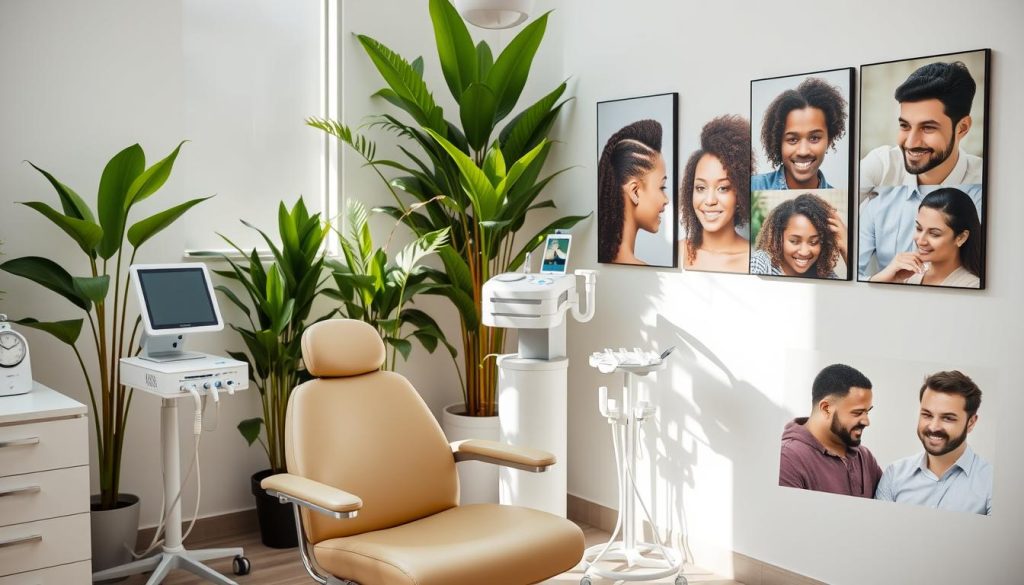
Several factors affect the cost of hair transplants. These include the technique used, the surgeon’s skill, and where the procedure is done. We’ll go into each to help you make a choice that fits your budget.
- Choice of Technique: FUE and FUT are two main methods. FUE might cost more but has less downtime and scarring.
- Surgeon’s Expertise: More experienced surgeons might charge more. But, they often need fewer sessions and give better results.
- Geographic Location: Prices can vary based on where you are. Looking around can help find cheaper options.
Looking into financing and payment plans can also help. Many clinics offer plans to spread out the cost. This makes the procedure more manageable.
| Technique | Average Cost | Expected Results |
|---|---|---|
| FUE | $4,000 – $15,000 | Less scarring, shorter recovery |
| FUT | $3,000 – $10,000 | Cost-effective, more noticeable scarring |
It’s important to do your homework and talk to experts. Discussing payment plans and what to expect is key. Choose a cost-effective hair restoration that fits your budget but doesn’t compromise on quality or lasting results.
Choosing the Best Hair Transplant Option for You
Starting your hair restoration journey is a big step. It’s not about finding a single solution that fits everyone. Instead, it’s about creating a personalized hair restoration plan that meets your unique needs. This is the key moment: understanding your goals, hair type, and lifestyle to find a solution that boosts your confidence and looks.
Every hair follicle has its own story. Your case is special and deserves a plan that matches the latest hair restoration methods. Think about the details like hair line design, donor hair type, and post-surgery care. Your choice should balance your beauty goals with practical needs, fitting into your daily life and future plans.
It’s your story that will guide you to the best hair transplant option. We believe in working with experts who focus on a personalized hair restoration plan. This approach combines science and art in hair transplantation. With the right team and support, your journey to natural-looking results will be enlightening. Knowledge and the right professionals will help you make a choice that shows off your individuality and the skill of modern hair restoration.
FAQ
Q: What are the best hair transplant options available in the USA?
A: The top hair transplant options in the USA are found at top clinics. Expert surgeons use FUE, FUT, and DHI to get natural results.
Q: How much does hair transplant surgery typically cost?
A: Hair transplant costs vary by technique, procedure extent, and location. It’s key to compare prices at different clinics.
Q: What are the top hair restoration techniques currently used?
A: The main techniques are FUE, FUT, and DHI. These advanced methods meet different patient needs.
Q: How can I find an affordable hair transplant option?
A: Look for affordable options by comparing prices at clinics. Discuss financing and cost-effective solutions without sacrificing quality.
Q: What factors contribute to a successful hair transplant?
A: Success depends on choosing the right surgeon and following care instructions. Regular follow-ups are also important.
Q: How do I identify the best hair transplant specialists in the USA?
A: Find top surgeons by checking qualifications and clinic ratings. Look at before and after photos to judge their work.
Q: Why are natural hair transplant results important?
A: Natural results ensure the transplanted hair looks like your own. This involves matching the hairline and choosing the right donor hair.
Q: What should I look for in before and after photos of hair transplant procedures?
A: Photos should show natural-looking results with a seamless blend. Look for consistent hair density and aesthetic improvement.
Q: What are the best hair transplant options for different hair types?
A: Techniques vary by hair type. Fine hair may need different approaches than thick or curly hair, tailored to each patient’s hair.
Q: Where can I find top-rated hair transplant clinics in the USA?
A: Top clinics are across the USA. Research clinics with great reviews, photos, and hair restoration excellence.
Q: How can I assess advanced hair restoration techniques?
A: Understand the role of robotics and AI in hair transplantation. Their effectiveness is shown by patient satisfaction and technology evidence.
Q: What is involved in planning my hair transplant?
A: Planning includes initial consultations and understanding the procedure. It also involves preparing for surgery and post-operative care.
Q: How can I balance quality and affordability when choosing a hair transplant?
A: Balance quality and cost by researching options and understanding costs. Look for financing solutions and avoid low prices at the expense of quality.
Q: How do I choose the best hair transplant option for me?
A: Consider your goals, hair type, and lifestyle. Consult specialists to create a personalized plan for natural and satisfying results.












